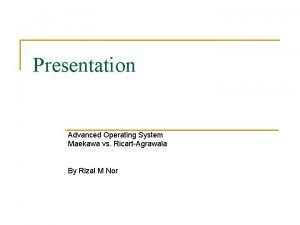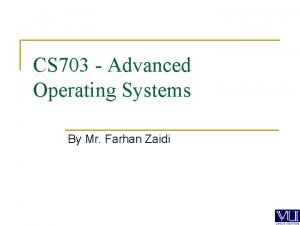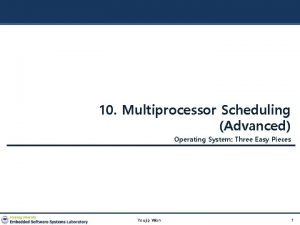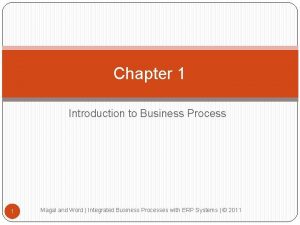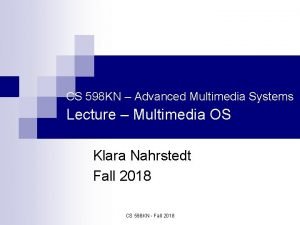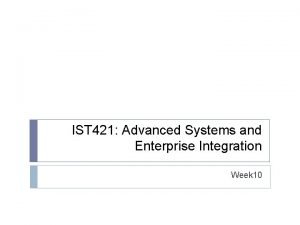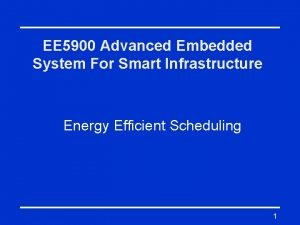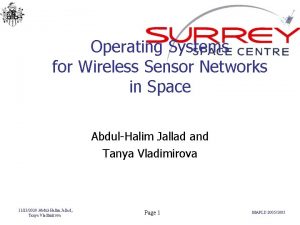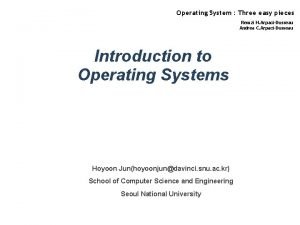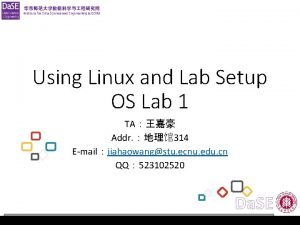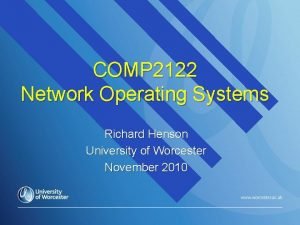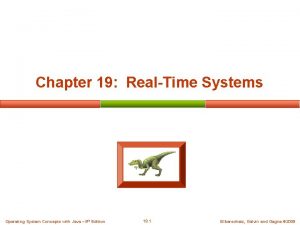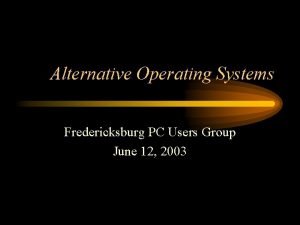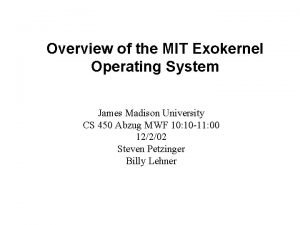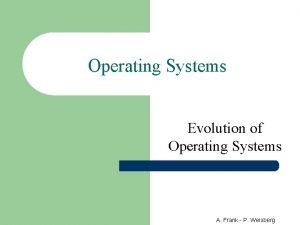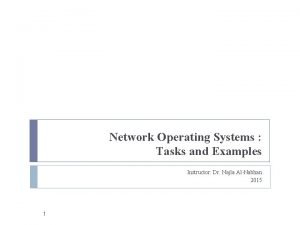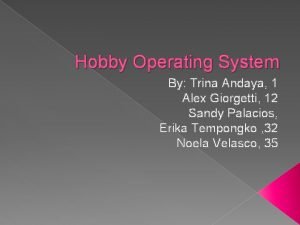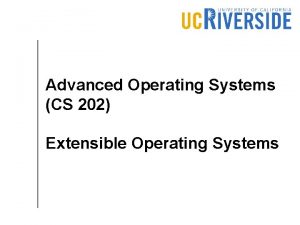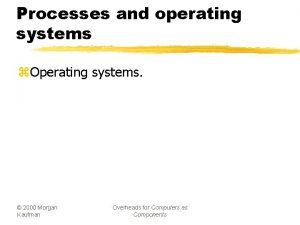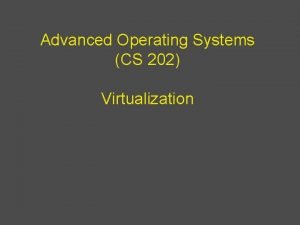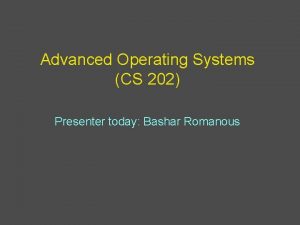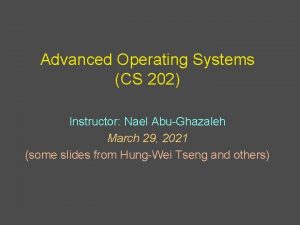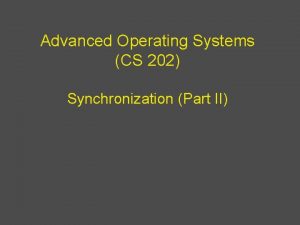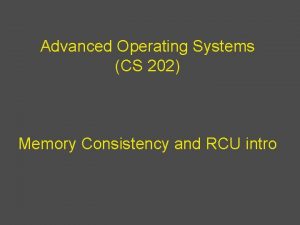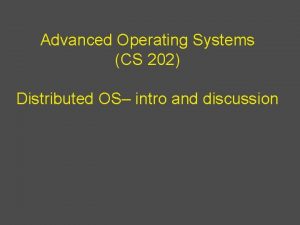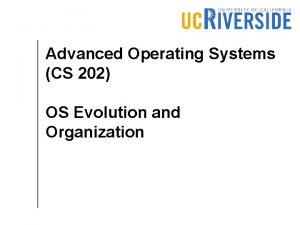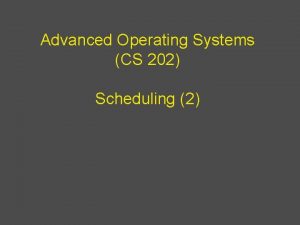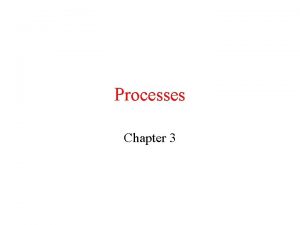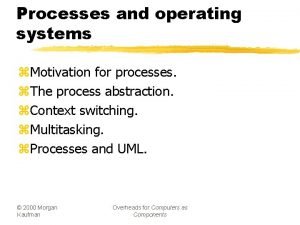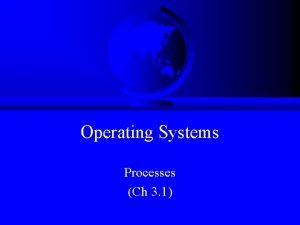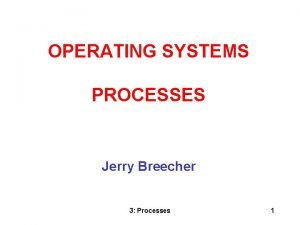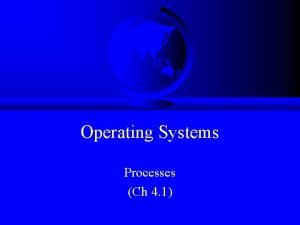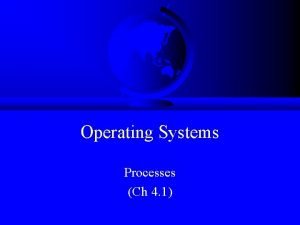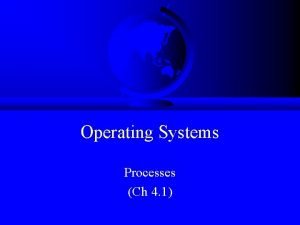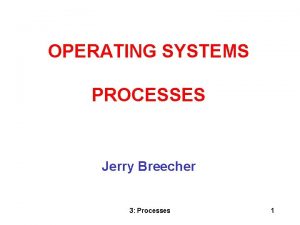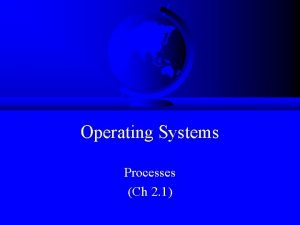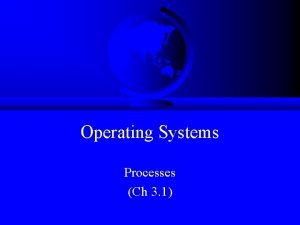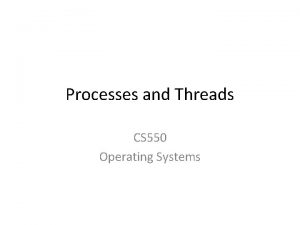Advanced Operating Systems CS 202 Processes continued 1











![fork() int main(int argc, char *argv[]) { char *name = argv[0]; int child_pid = fork() int main(int argc, char *argv[]) { char *name = argv[0]; int child_pid =](https://slidetodoc.com/presentation_image_h2/b11f3ce8ca332828e2eb2617bf7d6bf3/image-12.jpg)


![Example Continued [well ~]$ gcc t. c [well ~]$. /a. out My child is Example Continued [well ~]$ gcc t. c [well ~]$. /a. out My child is](https://slidetodoc.com/presentation_image_h2/b11f3ce8ca332828e2eb2617bf7d6bf3/image-15.jpg)




















- Slides: 35

Advanced Operating Systems (CS 202) Processes (continued) 1

How to pause/restart processes? When a process is running, its dynamic state is in memory and some hardware registers Hardware registers include Program counter, stack pointer, control registers, data registers, … To be able to stop and restart a process, we need to completely restore this state When the OS stops running a process, it saves the current values of the registers (usually in PCB) When the OS restarts executing a process, it loads the hardware registers from the stored values in PCB Changing CPU hardware state from one process to another is called a context switch This can happen 100 s or 1000 s of times a second! 2

How does the OS track processes? The OS maintains a collection of queues that represent the state of all processes in the system Typically, the OS at least one queue for each state Ready, waiting, etc. Each PCB is queued on a state queue according to its current state As a process changes state, its PCB is unlinked from one queue and linked into another 3

State Queues Ready Queue Firefox PCB Disk I/O Queue Emacs PCB X Server PCB Outlook PCB ls PCB Console Queue Sleep Queue. . There may be many wait queues, one for each type of wait (disk, console, timer, network, etc. ) . 4

Check your understanding True or False: a process can move from the running state to the waiting state Yes, when the process asks for a blocking system call True or False: There is a separate kernel stack and user stack for each process Yes, its dangerous to allow a process to access an OS page Where is process related information stored? In the Process Control Block 5

6

7

8

Process system call API Process creation: how to create a new process? Process termination: how to terminate and clean up a process Coordination between processes Wait, waitpid, signal, inter-process communication, synchronization Other E. g. , set quotas or priorities, examine usage, … 9

Process Creation A process is created by another process Why is the case? Parent is creator, child is created (Unix: ps “PPID” field) What creates the first process (Unix: init (PID 0 or 1))? In some systems, the parent defines (or donates) resources and privileges for its children Unix: Process User ID is inherited – children of your shell execute with your privileges After creating a child, the parent may either wait for it to finish its task or continue in parallel (or both) 10

Process Creation: Unix In Unix, processes are created using fork() int fork() Creates and initializes a new PCB Creates a new address space Initializes the address space with a copy of the entire contents of the address space of the parent Initializes the kernel resources to point to the resources used by parent (e. g. , open files) Places the PCB on the ready queue Fork returns twice Returns the child’s PID to the parent, “ 0” to the child 11
![fork int mainint argc char argv char name argv0 int childpid fork() int main(int argc, char *argv[]) { char *name = argv[0]; int child_pid =](https://slidetodoc.com/presentation_image_h2/b11f3ce8ca332828e2eb2617bf7d6bf3/image-12.jpg)
fork() int main(int argc, char *argv[]) { char *name = argv[0]; int child_pid = fork(); if (child_pid == 0) { printf(“Child of %s is %dn”, name, getpid()); return 0; } else { printf(“My child is %dn”, child_pid); return 0; } } What does this program print? 12

Duplicating Address Spaces child_pid = 486 PC child_pid = 0 child_pid = fork(); if (child_pid == 0) { printf(“child”); } else { PC } else { printf(“parent”); } Parent Child 13

Divergence child_pid = 486 child_pid = 0 child_pid = fork(); if (child_pid == 0) { printf(“child”); } else { printf(“parent”); PC PC } printf(“parent”); } Parent Child 14
![Example Continued well gcc t c well a out My child is Example Continued [well ~]$ gcc t. c [well ~]$. /a. out My child is](https://slidetodoc.com/presentation_image_h2/b11f3ce8ca332828e2eb2617bf7d6bf3/image-15.jpg)
Example Continued [well ~]$ gcc t. c [well ~]$. /a. out My child is 486 Child of a. out is 486 [well ~]$. /a. out Child of a. out is 498 My child is 498 Why is the output in a different order? 15

Why fork()? Very useful when the child… Is cooperating with the parent Relies upon the parent’s data to accomplish its task Example: Web server while (1) { int sock = accept(); if ((child_pid = fork()) == 0) { Handle client request } else { Close socket } } 16

Process Creation (2): Unix Wait a second. How do we actually start a new program? int exec(char *prog, char *argv[]) exec() Stops the current process Loads the program “prog” into the process’ address space Initializes hardware context and args for the new program Places the PCB onto the ready queue Note: It does not create a new process What does it mean for exec to return? What does it mean for exec to return with an error? 17

wait() a second… Often it is convenient to pause until a child process has finished Think of executing commands in a shell Use wait() (Wait. For. Single. Object) Suspends the current process until a child process ends waitpid() suspends until the specified child process ends Wait has a return value…what is it? Unix: Every process must be reaped by a parent What happens if a parent process exits before a child? What do you think is a “zombie” process? 18

Unix Shells while (1) { char *cmd = read_command(); int child_pid = fork(); if (child_pid == 0) { Manipulate STDIN/OUT/ERR file descriptors for pipes, redirection, etc. exec(cmd); panic(“exec failed”); } else { if (!(run_in_background)) waitpid(child_pid); } } 19

Some issues with processes Creating a new process is costly because of new address space and data structures that must be allocated and initialized Recall struct proc in xv 6 or Solaris Communicating between processes is costly because most communication goes through the OS Inter Process Communication (IPC) – we will discuss later Overhead of system calls and copying data 20

Parallel Programs • Also recall our Web server example that forks off copies of itself to handle multiple simultaneous requests • To execute these programs we need to • • Create several processes that execute in parallel Cause each to map to the same address space to share data • • • They are all part of the same computation Have the OS schedule these processes in parallel This situation is inefficient (Copy on Write helps) • • Space: Duplicate memory, PCB, page tables, etc. Time: create data structures, fork and copy addr space, etc. 21

Rethinking Processes What is similar in these cooperating processes? They all share the same code and data (address space) They all share the same privileges They all share the same resources (files, sockets, etc. ) What don’t they share? Each has its own execution state: PC, SP, and registers Key idea: Separate resources from execution state Exec state also called thread of control, or thread 22

Threads l Separate execution and resource container roles • • l The thread defines a sequential execution stream within a process (PC, SP, registers) The process defines the address space, resources, and general process attributes (everything but threads) Threads become the unit of scheduling • • Processes are now the containers in which threads execute Processes become static, threads are the dynamic entities 23

Recap: Process Address Space 0 x. FFFF Stack SP Address Space Heap (Dynamic Memory Alloc) Static Data (Data Segment) Code (Text Segment) PC 0 x 0000 24

Threads in a Process Stack (T 1) Thread 2 Thread 1 Stack (T 2) Stack (T 3) Thread 3 Heap Static Data PC (T 3) PC (T 2) Code PC (T 1) 25

Which of these are needed for each thread Stack pointer Register states ☒ Open file descriptors Program Counter ☒ Page table (or memory management information) 26

Which of these are needed for each thread Stack pointer Register states Open file descriptors Program Counter Page table (or memory management information) 27

Threads: Concurrent Servers Using fork() to create new processes to handle requests in parallel is overkill for such a simple task Recall our forking Web server: while (1) { int sock = accept(); if ((child_pid = fork()) == 0) { Handle client request Close socket and exit } else { Close socket } } 28

Threads: Concurrent Servers Instead, we can create a new thread for each request web_server() { while (1) { int sock = accept(); thread_fork(handle_request, sock); } } handle_request(int sock) { Process request close(sock); } 29

Implementing threads l Kernel Level Threads l u u l All thread operations are implemented in the kernel The OS schedules all of the threads in the system Don’t have to separate from processes OS-managed threads are called kernel-level threads or lightweight processes u u u Windows: threads Solaris: lightweight processes (LWP) POSIX Threads (pthreads): PTHREAD_SCOPE_SYSTEM 30

Kernel Thread (KLT) Limitations l KLTs make concurrency cheaper than processes u l Much less state to allocate and initialize However, there a couple of issues u Issue 1: KLT overhead still high Thread operations still require system calls Ideally, want thread operations to be as fast as a procedure call u l Issue 2: KLTs are general; unaware of application needs Alternative: User-level threads (ULT) 31

Alternative: User-Level Threads Implement threads using user-level library ULTs are small and fast A thread is simply represented by a PC, registers, stack, and small thread control block (TCB) Creating a new thread, switching between threads, and synchronizing threads are done via procedure call No kernel involvement User-level thread operations 100 x faster than kernel threads pthreads: PTHREAD_SCOPE_PROCESS 32

Summary KLT vs. ULT Kernel-level threads Integrated with OS (informed scheduling) Slow to create, manipulate, synchronize User-level threads Fast to create, manipulate, synchronize Not integrated with OS (uninformed scheduling) Understanding the differences between kernel and user-level threads is important For programming (correctness, performance) For test-taking 33

Sample Thread Interface thread_fork(procedure_t) Create a new thread of control Also thread_create(), thread_setstate() thread_stop() Stop the calling thread; also thread_block thread_start(thread_t) Start the given thread_yield() Voluntarily give up the processor thread_exit() Terminate the calling thread; also thread_destroy 34

Looking ahead OS Model We have assumed monolithic kernel Are there disadvantages to that? What alternatives are there? Scheduling How do we decide which thread to run next? Concurrency and synchronization We have to manage concurrency for correctness But also for performance/scalability Both OS and general multi-threaded programming problem Multi-core->many-core 35
 Concurrent processes are processes that
Concurrent processes are processes that Operating system lecture notes
Operating system lecture notes Ricart-agrawala algorithm code in java
Ricart-agrawala algorithm code in java Advanced operating system
Advanced operating system Mqms
Mqms Integrated business processes with erp systems
Integrated business processes with erp systems Advanced fusion systems llc
Advanced fusion systems llc Advanced fueling systems
Advanced fueling systems Cs598
Cs598 Marine fluid systems
Marine fluid systems Tom kilcer advanced ag systems
Tom kilcer advanced ag systems Advanced systems integration
Advanced systems integration Advanced embedded systems
Advanced embedded systems Enotes fst
Enotes fst Advanced cooling systems inc
Advanced cooling systems inc Example of a operating system
Example of a operating system Evolution of operating systems
Evolution of operating systems Components of an operating system
Components of an operating system What is operating system
What is operating system Wsn operating systems
Wsn operating systems 3 easy pieces
3 easy pieces Operating systems lab
Operating systems lab Dual mode in os
Dual mode in os Modern operating systems tanenbaum
Modern operating systems tanenbaum File management components
File management components Design issues in distributed system
Design issues in distributed system Early operating systems
Early operating systems Real-time operating systems
Real-time operating systems Can we make operating systems reliable and secure
Can we make operating systems reliable and secure Alternative operating systems
Alternative operating systems Mit operating system
Mit operating system Operating system internals and design principles
Operating system internals and design principles Evolution of operating systems
Evolution of operating systems Network operating system examples
Network operating system examples Msdn operating systems subscription
Msdn operating systems subscription Hobbyist operating system
Hobbyist operating system


